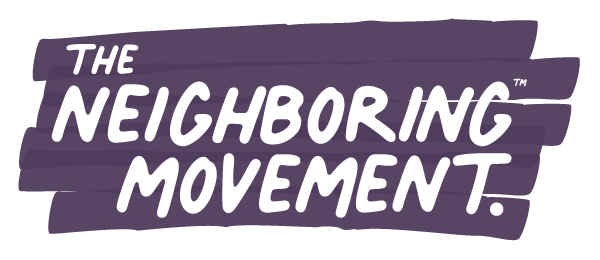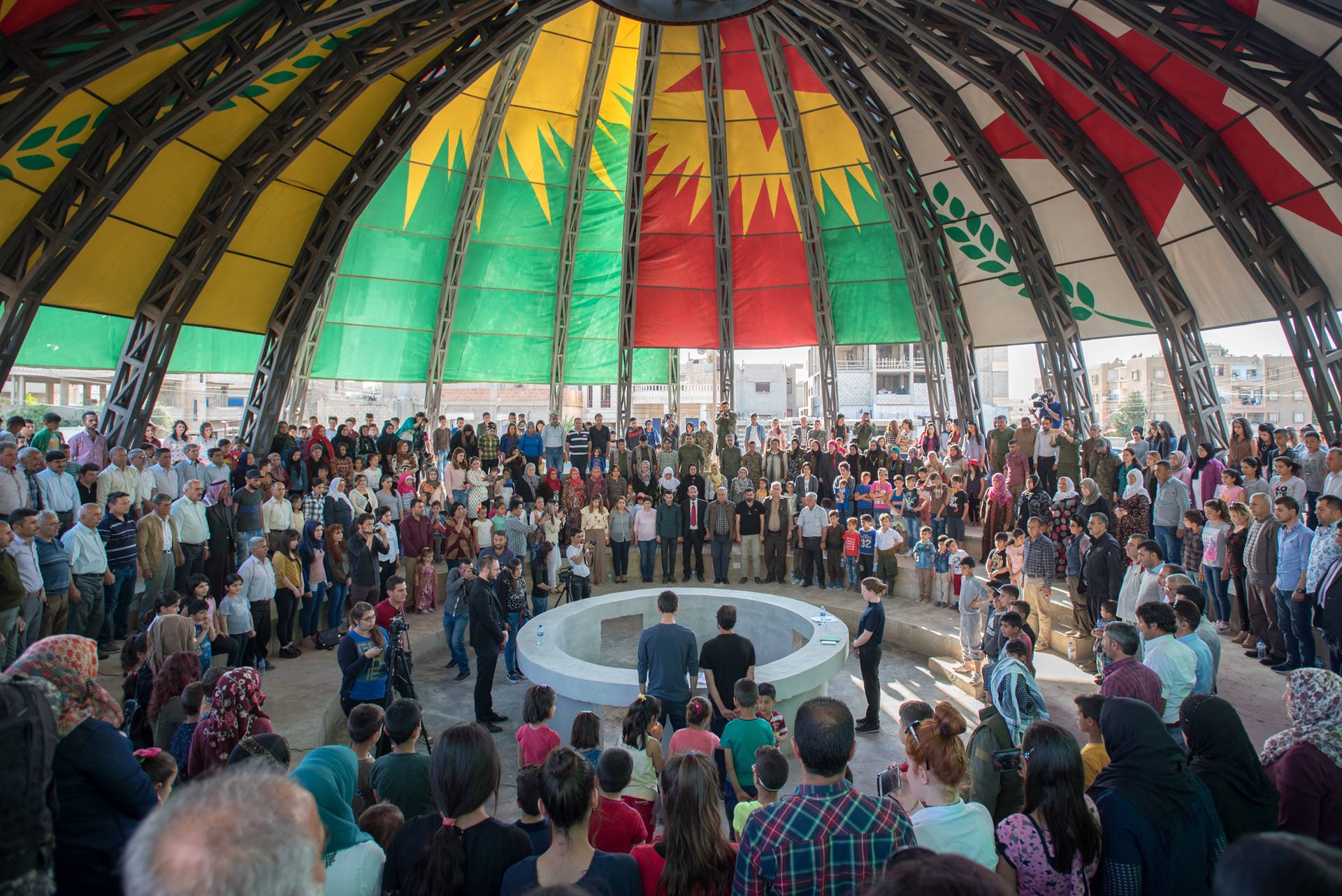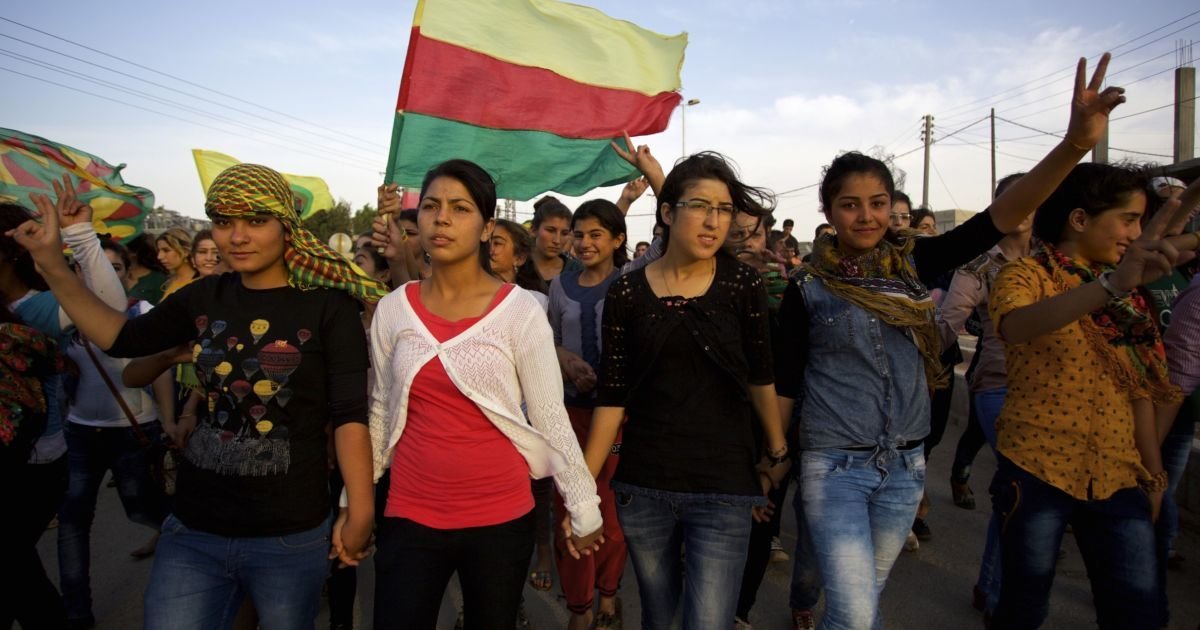A “Neighboring Revolution” Is Under Attack
Today we are releasing an emergency blog post and podcast as one of the most globally important examples of neighbor power and possibility is under full-scale military assault. For our podcast we interviewed Samantha Teal, a media activist on the ground in North and East Syria, but this blog post will give some extra background for a very complex situation.
Let me give a content warning from the beginning. While this post, like all of them, will certainly cover some inspiring examples of beautiful neighbor-to-neighbor relationships and self-organization, I (Ian) am also covering topics of military occupation and invasion and all the horrors of war, injustice, and colonialism. Please prepare accordingly, but if you can come back to this, please do because this story needs to be heard, especially among relatively privileged people.
Neighbors in the North East Syrian city of Qamishlo meet on their block to organize their lives together. Image source unknown.
On The Neighboring Movement podcast, we are starting an international neighboring series to stimulate our imaginations. If people really started to take neighboring seriously, if people started discovering, connecting, and mobilizing the gifts of neighbors right on their blocks towards their shared common dreams, what worlds are possible? Who is doing amazing things in neighboring in their contexts that we can learn from? Every locality and culture has its own specific context and radical experiments like the one this article will focus on often arise from truly desperate circumstances so we cannot and would not want to hold up examples from other places as exact replicas.
That said, sometimes seeing examples from other places that see the same stars in the night sky as we do can give us an idea of what is possible. For several years now, I (Ian, representing only myself) have been in dialogue with civilians, organizers, and officials from North and East Syria, helping connect them to similar movements around the world (ie. the Neighborocracy movement in India) that are organizing drastically new social arrangements which intentionally disperse power to assemblies of neighbors and average citizens, especially women. These people are doing incredible, courageous, difficult work and their resilience has given me so much hope. They refer to me as a heval, which is close to meaning “friend” but gives a deeper connotation of a relationship that is born of shared struggle for freedom and justice.
Sometimes the greatest beauty can come out of the most dire circumstances. The autonomous region of North and East Syria is generally considered one of the safest, and definitely the freest, region in all of Syria. This is thanks to an almost unthinkably bold social revolution that has emerged from under the shroud of the darkness that has faced Syria as a whole since 2011.
When many Americans look at Syria, they think ISIS, the most brutal fanatical terrorist organization we have seen in our lifetimes. The Islamic State (ISIS or pejoratively called "Daesh") once held massive chunks of Syria and Iraq, spreading fear and atrocities with each advancing step. Such horrific evils, however, were matched, to the surprise of the Western gaze, with its equally formidable diametric opposite: a bottom-up, women-centered democracy was budding simultaneously and laid down a line that Daesh could never cross. Headlines and press photos showed courageous all-women's and mixed-gender units of young fighters tearing through the ISIS lines, but journalists rarely dug deep enough under the surface to see the remarkable pluralistic social forces that propelled this resistance.
Communities of Kurds, Assyrians, Arabs, Armenians, and Yezidis in North and East Syria (colloquially called "Rojava") have spent the last 11 years dealing with far worse versions of the uncertainty and precarity we are just now beginning to face with our price hikes, climate disasters, and supply chain shortages. They turned to their neighbors to get themselves through civil war and ISIS attacks, and are emerging through it all with a renewed society that is far more beautiful and far more free than they had before. It’s a story of hope and I think it is very instructive for us about the possibilities that can emerge from a crisis like a pandemic, natural disaster, or loneliness epidemic when neighbors start to become conscious of themselves as a network of shared survival.
Neighbors make many decisions in assemblies and send delegates to voice their points of view to larger meetings like this one.
This is where this revolution becomes especially relevant to The Neighboring Movement. The Autonomous Administration of North and East Syria (AANES), the region’s official name, can be called “a democracy of neighbors.” Their system gives us a glimpse of what it would look like if the most important hub of democracy was intentional assemblies of neighbors, gathered together block-by-block, street-by-street, apartment unit by apartment unit to celebrate life together, share together, discuss together, decide together, and act together in a fully-inclusive, fully participatory manner. At its best, it is a picture of a life freed from deeply divided, hyperpartisan national politics far removed from the realities of everyday people.
Instead politicians and government obey and convey: they are given specific instructions by their street and neighborhood assemblies which they convey to the next level of representation- towns, cities, regions, and the Autonomous Administration as a whole. Power flows from the bottom-up, allowing the vast majority of the decisions that affect the lives of the people to be made directly by the people themselves. But there would be no way for people to deliberate over those decisions, come to agreement on them, enforce them, and protect them if they did not spend decades quietly rebuilding their social fabric- a strong, deeply interwoven network of neighbors dedicated to taking care of each other and connecting and mobilizing their gifts, one block at a time.
But let’s take a step back. In the 1970s and early 80s, the Kurdish people who would eventually catalyze what is called the “Rojava Revolution” were far from an interwoven network. Yes, they had a rich communal culture and heritage that elders could remember and try to keep alive, but after a hundred years of constant oppression from four different nation-states that trapped Kurds in the middle, they were facing a state of what their leading theorist Abdullah Ocalan called “societycide.”
State powers had so pit Kurds against Kurds and other cultures against Kurds (really neighbors against neighbors) that the once-vibrant and communally connected society was on the verge of non-existence. Four nation-states had been built right over the traditional homelands of Kurdish people: Syria, Turkey, Iraq, and Iran. Kurds were variously denied the ability to speak their language, sing their songs, denied their very existence as a category in some states, barred from citizenship in others, and even prevented from growing fruit trees or having any of their own means to sustain themselves. Forty years ago, oppression and fear were rapidly draining Kurds and other marginalized populations of what we call “social capital.”
In the 1970s however, Kurds started fighting back against their oppression, sometimes making common cause with other oppressed minorities such as the Assyrian Christians. One manifestation of this fight was with armed guerrilla groups, but there were vastly more people engaged in organizing a healthier day-to-day civilian life. In Northeast Syria, activists and families spent decades secretly and illegally organizing support structures to fill the gaps that the state left in their communities. Eventually, their homegrown ideology of Democratic Confederalism won favor among many different ethnic groups in the region.
Democratic Confederalism is a kind of hyperlocal direct democracy where local people band together to meet their needs themselves and ultimately make the states that have left them out to dry obsolete. It emphasizes ethnic and religious pluralism, women’s freedom, and ecology, in stark contrast to priorities of the authoritarian states dominating the region. This is the background that takes us to 2012, when the Syrian government completely pulled out of Northeast Syria to fight a civil war in their major cities, leaving a power vacuum. That vacuum could have been filled by jihadists or aspiring authoritarians as in many parts of Syria, but instead the local people were able to piece together clandestine building blocks to govern their own lives in a remarkably smooth transition.
One of these building blocks became what they called “communes.” Despite the same name, the word has a completely different cultural connotation there from the “hippy communes” we might think of here.
By commune, they mean a coordination of neighbors on the most local level, say 200-300 households, to pool resources, strengthen social life, and use direct democracy to decide on the decisions that most affect the people that live there. Neighbors are all welcome and encouraged and trained to participate in the commune, the most important political entity in the society. This makes neighbors, not politicians, the most important political actors of North and East Syria.
Their democratic confederalist system has proved remarkably resilient, powering the defeat of the once-unstoppable ISIS caliphate. This system has weathered myriad threats including attacks from genocidal surrounding states, embargo that blocked most medical supplies during the pandemic and continues today, internal prejudices and oppressive attitudes, climate change, wildfires, and the constant threat of a Turkish invasion. Turkey has in fact launched full-scale invasions of North and East Syria twice, using ground troops, air power, and local radical jihadist militias in ethnic cleansing operations. The United States government insists on playing an “objective” form of politics where “strategic interests” and not ethics or human rights are paramount. The defense forces (SDF) of the AANES were America’s number one ally in the defeat against ISIS, and US general Jonathan Braga called the joint effort “one of the most successful indigenous-force partnership relationships in US military history.” And yet, those same defense forces are ideologically aligned with the PKK, the guerrilla group whose leader created the ideology of Democratic Confederalism.
Women march in a popular demonstration. (Photo by: Andia/UIG via Getty Images)
The problem is, Turkey considers the PKK and anyone who shares a history with the PKK a terrorist group. Turkey also holds incredible weight in foreign affairs. Despite long sliding away from any notion of democracy and towards repressive dictatorship, the Turkish state has huge bargaining power over the US and Europe because of their using refugees from the Middle East as political pawns, their housing of US nuclear weapons, and their strategic location between multiple important geopolitical regions.
Thus, the US constantly has to deny the shared ideology of the PKK and SDF to protect their fight against ISIS but also has to refuse to lend the SDF any legitimacy or support economically, politically, or militarily except when it can be explicitly traced to fighting ISIS. The US was left begging Turkey to stop attacking the SDF under the guise of “clearing SDF terrorists” while the SDF was trying to focus on clearing the last settlements of an internationally agreed-upon terrorist group ISIS in 2018 and 2019. The US did not have forces in one area of AANES territory that Turkey took in 2018 so they remained silent. After enough threats to invade again in 2019, President Trump let Turkey invade by pulling away US forces from their targets. The new status quo seems to be that the US will look the other way as Turkey drone strikes AANES civilians, politicians, civil society workers, soldiers, and military officials as long as Turkey does not launch a full-scale invasion which could interrupt counter-insurgency campaigns against ISIS. Meanwhile, the Biden administration is moving ahead with the sale of 40 F-16 fighter jets to Turkey which will be used to bomb US allies in the fight against ISIS and the region’s civilians and infrastructure.
RIC documented Turkish airstrike damage on October 7, 2023 at the Covid-19 hospital facility near Derik. This was a warplane rather than drone attack, as evidenced by the crater size.
This status quo brings us to this past week. A guerrilla attack in Turkey injured two police officers. Turkey argued the attackers crossed the border from Syria, a claim the AANES has repeatedly denied. Turkey responded by bombing 172 key infrastructure sites (as of Monday) in North East Syria, a region already reeling from war and embargo. In all major cities in the region, Turkish strikes have struck power stations, oil fields, gas plants, hospitals, and on Sunday night, a base of the internal security forces, killing 29 members of mostly Anti-Drug trafficking units.
So what does this have to do with The Neighboring Movement? It has less to do with this organization proper, than it does have to do with all “neighboring movements” around the world. Anyone who believes in the power and promise of neighboring, who believes that average people should be able to participate directly in the decisions that affect them, that all ethnic groups and cultures and religions should celebrate their diversity, that women and ethnic minorities should be able to organize autonomously with equal/proportional representation, that democracy is about far more than ticking a box by one of two candidates’ names every four years, should care deeply that the most imagination-expanding revolution maybe ever is under threat.
The friends that I have met from North and East Syria, the Kurdish people and their Arab, Assyrian, Yezidi, and Armenian friends, and all those who organize as part of “democratic confederalist” movements around the world are the most resilient, hopeful, welcoming, and creative people I have ever met. Because they have zero doubt in their mind that their movement and people can withstand whatever firepower the Turkish military and other powers throw at them, I have zero doubt, too. And yet, everyday, life gets harder and harder as infrastructure that took years to rebuild after the last airstrike is reduced to smithereens in a fraction of a second. Loved ones are killed. The beloved ecological beauty of the region is poisoned and set ablaze.
Without an Autonomous Administration of North and East Syria, a testament to the human capacity for resistance, for pluralism, for grassroots democracy, for women’s liberation (at levels not seen anywhere else in the world) will be lost. We in America have everything to learn from them, and the bombs are designed to make us forget. Yet these movements and storied peoples will endure. We can all play our part in making it easier for them. Nothing boosts morale like tangible international solidarity.
WHAT YOU CAN DO:
Sign and circulate this petition, as individuals but especially as collective organizations.
Call your representatives: use this toolkit to make your calls to your representatives, and pledge to urge 3-5 other friends to make these calls. It is urgent that we defend North and East Syria at this critical time to prevent the potential sale of F-16 and other war equipment to Turkey, which have been used against the people in North and East Syria.
Organize your neighborhood: Time and time again, my friends in NES have told me that the best way to help them is to build on their example by imagining what a grassroots democracy of neighbors would look like in your neighborhood and then doing the work to bring it to life. When everyone can experience the collective freedom and responsibility (and joy, relationship, and abundance) that comes with organizing towards common dreams with one’s neighbors, they will be far more likely to want to protect others’ right to do the same. In America, we have to start by shifting our cultures slowly but surely towards cultures of neighborly interdependence. Here is one place to start.
To learn more about the inspiring commune system in NES, you can watch this short “documentary” I made 5 years ago.
You can also read the social contract of The Autonomous Administration of North and East Syria here.
Ian Campbell
The Neighboring Movement




